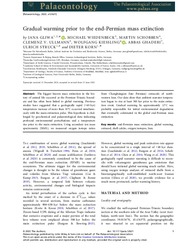Gradual warming prior to the end‐Permian mass extinction
Wiedenbeck, Michael
Schobben, Martin
Ullmann, Clemenz V.
DOI: https://doi.org/10.1111/pala.12621
Persistent URL: http://resolver.sub.uni-goettingen.de/purl?gldocs-11858/10280
Persistent URL: http://resolver.sub.uni-goettingen.de/purl?gldocs-11858/10280
Gliwa, Jana; Wiedenbeck, Michael; Schobben, Martin; Ullmann, Clemenz V.; Kiessling, Wolfgang; Ghaderi, Abbas; Struck, Ulrich; Korn, Dieter, 2022: Gradual warming prior to the end‐Permian mass extinction. In: Palaeontology, Band 65, 5, DOI: 10.1111/pala.12621.
 |
Dokument öffnen: |
The biggest known mass extinction in the history of animal life occurred at the Permian–Triassic boundary and has often been linked to global warming. Previous studies have suggested that a geologically rapid (<40 kyr) temperature increase of more than 10°C occurred simultaneously with the main extinction pulse. This hypothesis is challenged by geochemical and palaeontological data indicating profound environmental perturbations and a temperature rise prior to the main extinction. Using secondary ion mass spectrometry (SIMS), we measured oxygen isotope ratios from Changhsingian (late Permian) ostracods of north‐western Iran. Our data show that ambient seawater temperature began to rise at least 300 kyr prior to the main extinction event. Gradual warming by approximately 12°C was probably responsible for initial environmental degradation that eventually culminated in the global end‐Permian mass extinction.
Statistik:
ZugriffsstatistikSammlung:
This is an open access article under the terms of the Creative Commons Attribution License, which permits use, distribution and reproduction in any medium, provided the original work is properly cited.

